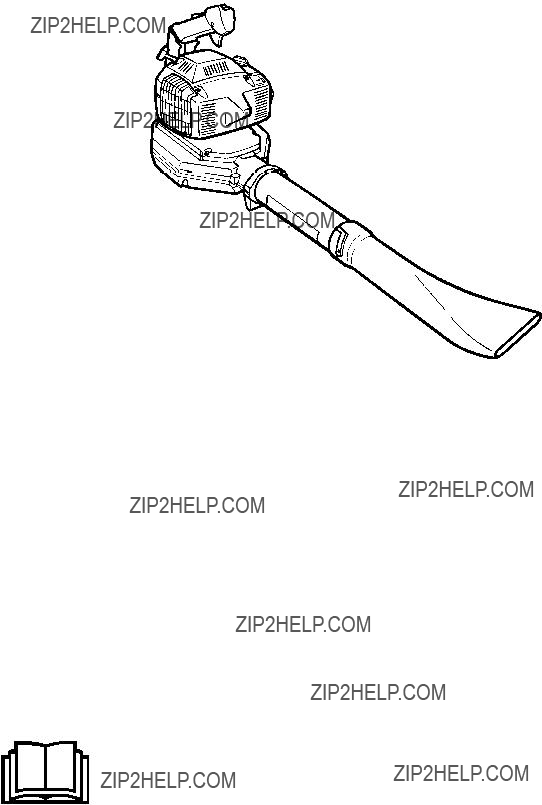
225B
Operator??s manual
Read the operator???s manual carefully and make sure that you understand the contents before using the blower.
114 00

225B
Operator??s manual
Read the operator???s manual carefully and make sure that you understand the contents before using the blower.
114 00
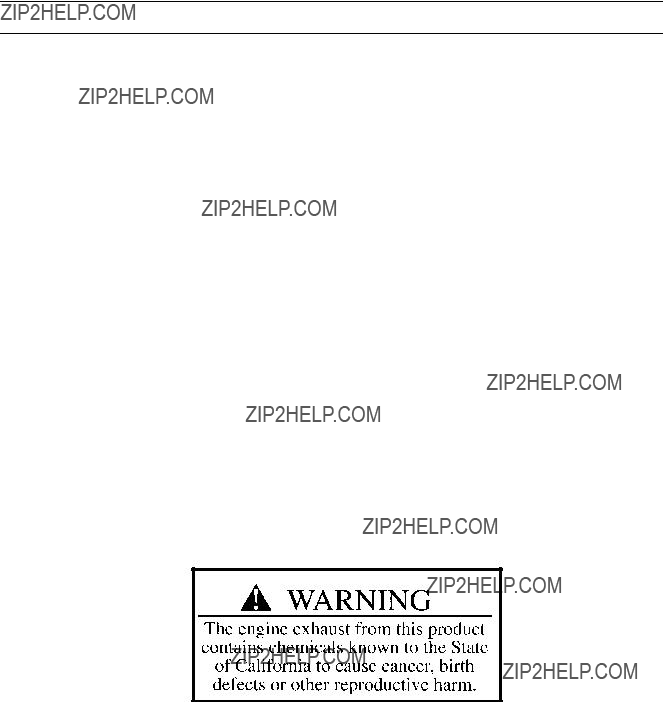
CONTENTS
Maintenance, replacement, or repair of the emission control devices and systems may be performed by any nonroad engine repair establishment or individual.
2 ??? English
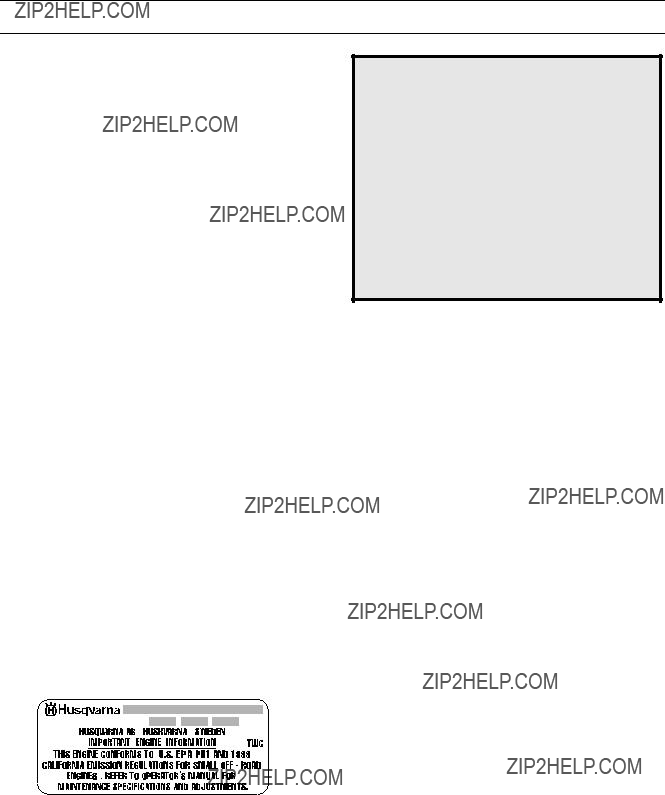
INTRODUCTION
Husqvarna AB has a policy of continuous product development and therefore reserves the right to modify the design and appearance of products without prior notice.
This operator???s manual describes in detail how to use and service the blower and how to carry out regular maintenance. It also describes which meas- ures should be taken to achieve maximum safety while operating the blower, how the safety devices work and how they should be serviced.
Note! The section of the manual that deals with safety, must be read and understood by all persons who come in contact with the blower.
This operator???s manual has been written for those who need guidance when it comes to fault tracing, thorough servicing and carrying out corrective maintenance of the blower.
There are warning symbols on the blower. These are illustrated on page 3. Should any of the warning symbols on the blower become disfigured or worn, new ones should be ordered and fitted to the blower as soon as possible. Note that some of the warning symbols are molded in certain components of the blower.
The blower is used for blowing away leaves and other debris on the ground. When operating the blower, the operator must stand with both feet firmly on the ground.
This decal certify that the product has been approved in accordance with American exhaust emission requirements EPA 1 and CARB 95.
!WARNING!
Under no circumstances may the design of the machine be modified without the permission of the manufacturer. Always use genuine accessories.
Your warranty does not cover damage or liability caused by the use of
English ??? 3
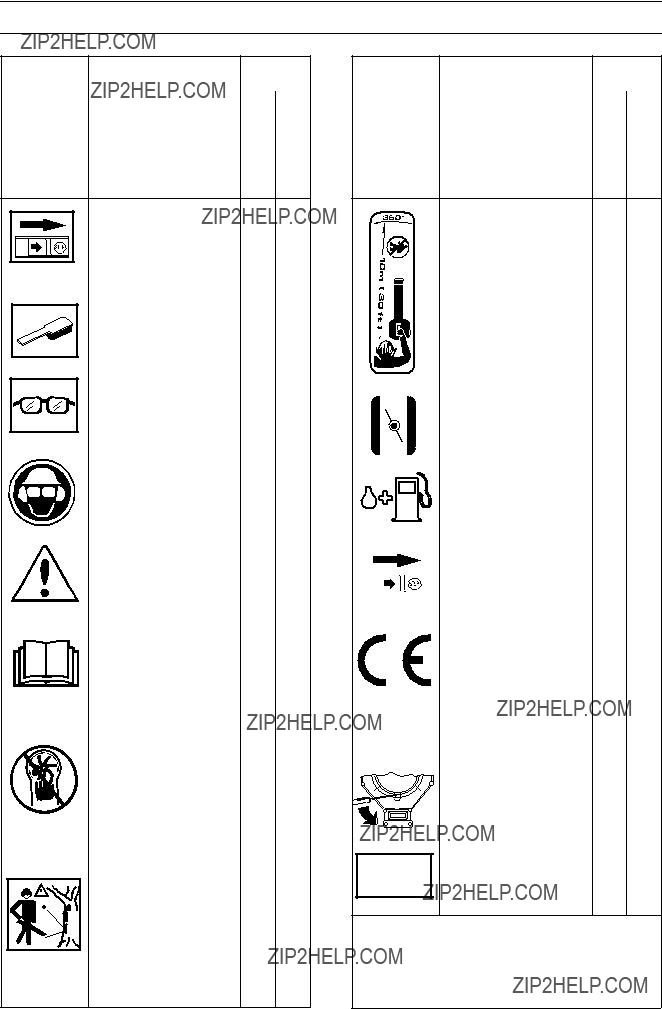
KEY TO SYMBOLS
Symbol Description
Checks and/or
Cleaning at regular intervals is required.
Approved protect goggles or visor must be worn.
Approved protect goggles or visor and ear protection must be worn.
WARNING! The blower can be dangerous! Careless or improper use can cause serious, even fatal injury.
Read the operator???s
WARNING! Make sure that the inspection cover is locked in the closed position or that the vacuum tube is mounted on the blower. Never touch the impeller.
WARNING! The blower may throw objects at high velocity that can ricochet and hit the operator. This may cause serious eye damage.
Location
X
X
X X
X X
X X
X X
X X
The blower operator
must make sure that no X X bystanders or animals
come nearer than 10 metres. Whenever several operators are working in the same work area, they should maintain a safe distance of at least 10 metres from one another.
Choke.X
Refueling.X
The manufacturer???s warrantee for this
product meets safety X X requirements according
to:
???The Machine Directive ???The EMC Directive ???The Low Voltage
Directive
Other symbols/decals on the machine refer
to special certification requirements for
certain markets.
4 ??? English
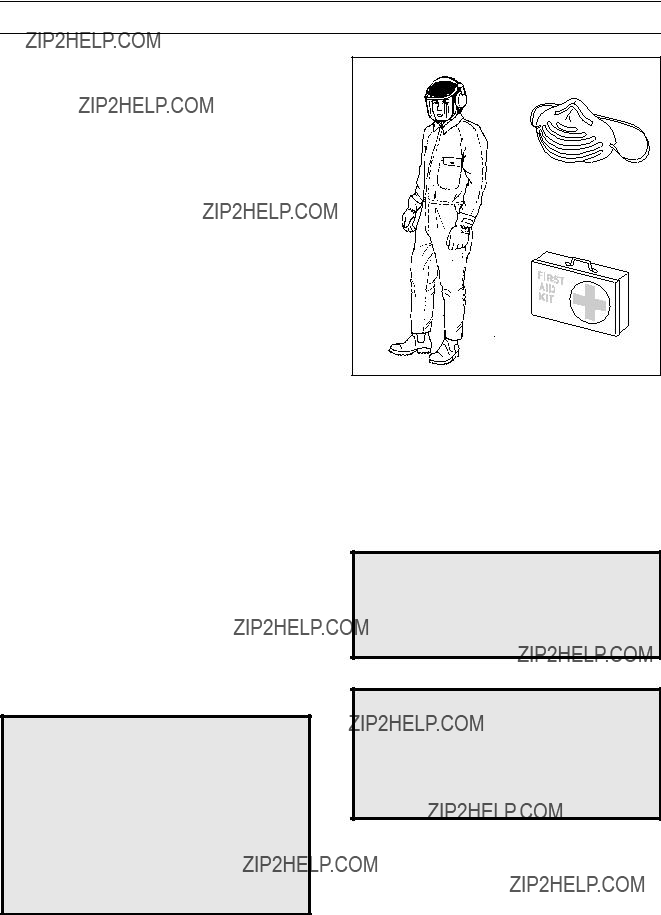
SAFETY INSTRUCTIONS
Personal safety equipment
Persons who use the blower shall wear the following safety equipment:
1.Approved ear protection.
2.Approved eye protection.
3.Face mask when operating the blower in dusty environments.
4.Boots or work shoes with a
5.
Personal safety
1+23
The following instructions apply to persons operating the blower:
1.The operator shall have read and understood the contents of this manual.
2.Do not wear loose clothing, scarves or neck chains or let long hair hang loose, since these can be drawn into rotating parts of the blower and cause injury.
3.Do not operate the blower while under the influence of alcohol, drugs or when you are tired.
4.Do not allow minors to operate the blower.
Fuel safety
!WARNING!
The fuel used to run the blower has the following dangerous
1.Volatile liquid, its vapor and exhaust fumes are poisonous.
2.Direct contact can cause skin irritation.
3.It is extremely combustible.
Special safety instructions apply to the type of fuel used for the blower. These instructions are specified under ???Fuel handling??? on pages 11 and 12.
Muffler
The muffler is designed to give the lowest possible noise level and to direct the engine???s exhaust fumes away from the operator. Muffler fitted with catalytic converter is also designed to reduce harmful exhaust components.
!WARNING!
The exhaust fumes from the engine are hot and may contain sparks which can start a fire. Never start the machine indoors or near combustible material!
!WARNING!
Mufflers fitted with catalytic converters become extremely hot during use and after stopping. This also applies at idling speeds. Contact can result in burns to the skin. Be observant to the risk of fire!
English ??? 5
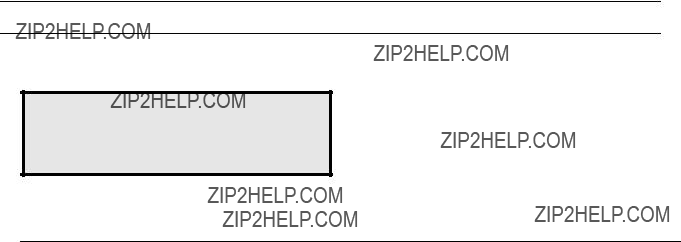
SAFETY INSTRUCTIONS
Safety equipment
!The blower must never be used if any of the safety devices or
guards are missing, damaged or not in working order.WARNING!
The blower is equipped with a number of safety devices and guards for the prevention of accidents. These are described in the general description of the blower on page 8.
The safety devices and guards also require regular inspection and maintenance. These measures and the interval at which they should be carried out are specified under ???Maintenance??? on pages 23 and 24.
Safety while operating the blower
1.Do not allow bystanders or animals to be in the work area, i.e. 10 metres from the operator.
2.The blower may throw objects at high velocity that can ricochet and hit the operator. This may cause serious eye damage.
3.Never point the blower nozzle toward people or animals.
4.Stop the engine before fitting or dismantling accessories or other components.
5.Never operate the blower if any of the guards is missing.
6.Never operate the blower in poorly ventilated spaces where exhause fumes might otherwise be inhaled.
7.Stop the engine before refueling.
8.The catalytic muffler is extremely hot while the blower is running and after it has stopped. The same applies when the blower is running at idling speed. Be aware of the danger of fire, especially while operating the blower near combustible materials and/or where combustible fumes are present.
9.Be careful, particurlarly if left hand operation is applied. Avoid any direct body contact with the exhaust outlet area.
10.Do not operate the blower while standing on a ladder or a stand.
Other safety measures
1.Operate the blower only at reasonable hours, i.e. not early in the morning or late at night when people might be disturbed. Comply with times listed in local ordinances. Usual recommend- ations are 9:00 a.m. to 5:00 p.m. Monday through Saturday.
2.Operate the blower at the lowest possible throttle setting to do the job.
3.Check the condition of the blower before opera- tion, especially the muffler, air intake and air filter.
4.Use a rake or a broom to loosen ground debris before blowing.
5.Under dusty conditions, slightly spray the work area with a hose or use a mister attachment when water is available.
6.Conserve water by using blowers instead of hoses for many lawn and garden applications, including areas such as roof gutters, screens, patios and gardens etc.
7.Watch out for children, pets, open windows or freshly washed cars, and blow debris safely away.
8.Use the full nozzle extension so the air stream can work close to the ground.
9.After using the blower, clean up and dispose of debris in trash receptacles
6 ??? English
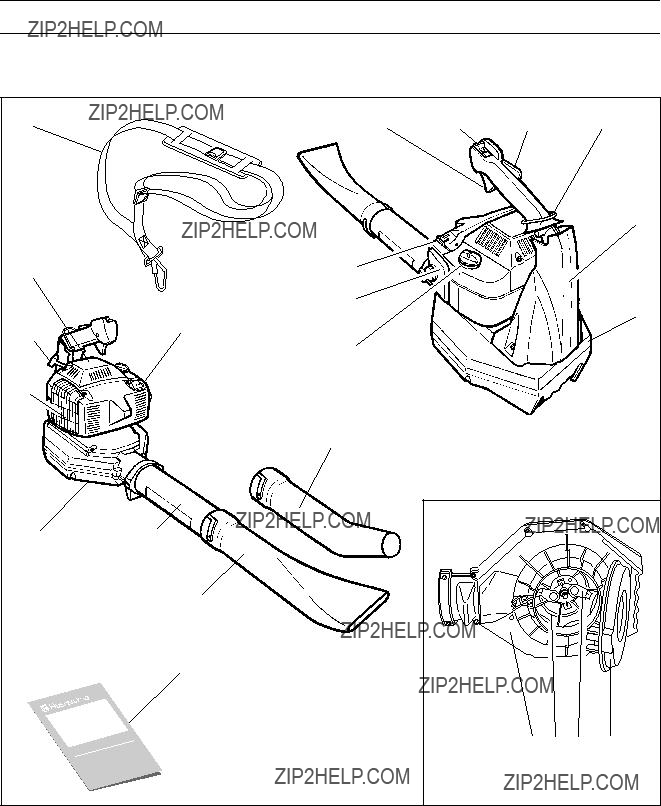
DESCRIPTION
The blower
English ??? 7
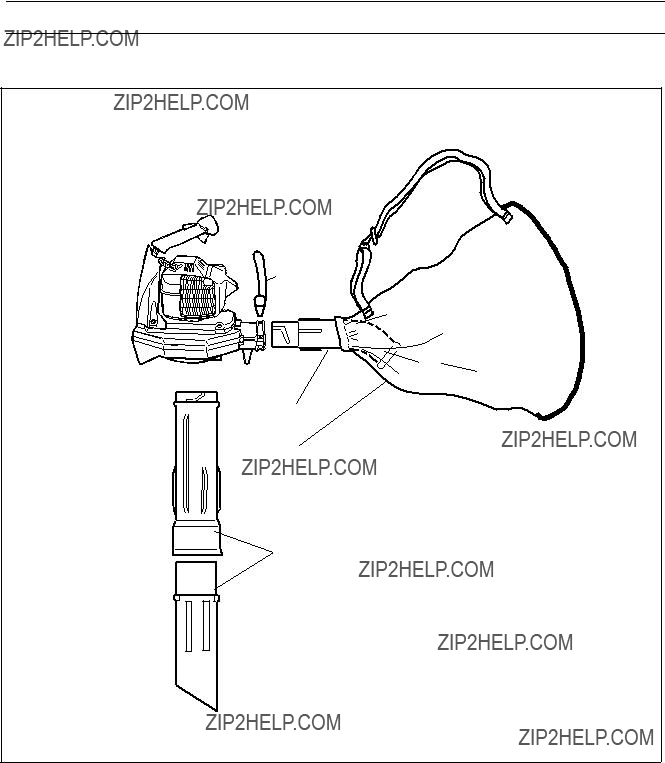
DESCRIPTION
Accessories
21
25
22
23
24
21.Vacuum device with collection components consisting of items 22 - 25 below.
22.Vacuum bag tube.
23.Collection bag.
24.Vacuum tube in two sections.
25.Auxiliary handle.
8 ??? English
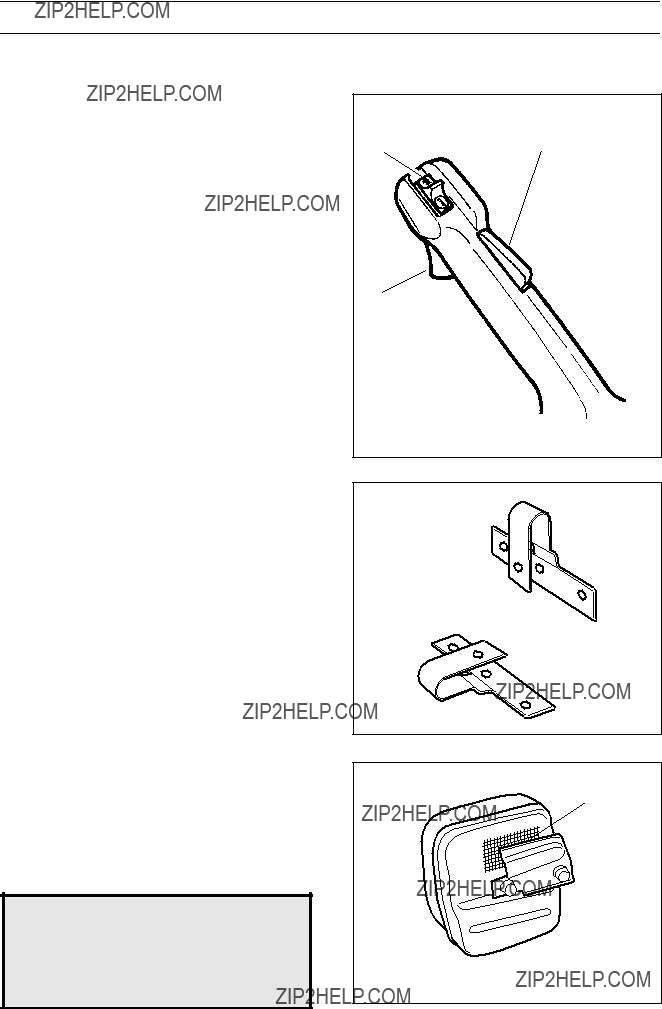
DESCRIPTION
Safety equipment
The following equipment on the blower is designed for protecting personnel and materials. These com- ponents should receive special attention whenever you operate, inspect and service the blower.
Stop switch (3)
The stop switch is used to stop the engine.
Throttle lock (4)
The throttle lock prevents inadvertent activation of the throttle. When the throttle lock is pressed into the handle (when gripping the handle) the throttle trigger (2) is disengaged. When the operator releases his/her grip on the handle, both the throttle trigger and the throttle lock are reset to their original settings by means of two spring systems which work inde- pendently of one another.
The
Muffler(16)
The muffler is designed to give the lowest possible noise level and to direct the engine???s exhaust fumes away from the operator. Muffler fitted with catalytic converter is also designed to reduce harmful exhaust components.
The engine exhaust fumes are hot and can contain sparks, which may cause fire if they come in contact with dry or combustible material.
Some blower models, esp. those sold in countries where the climate is dry, are equipped with spark- arresting mesh (A). This mesh must be cleaned or replaced at specific intervals. Check if your blower muffler has mesh of this type.
!WARNING!
The muffler is extremely hot while the engine is running and after it has stopped. DO NOT TOUCH THE MUFFLER IF IT IS HOT! This can cause severe burns.
2
A
English ??? 9
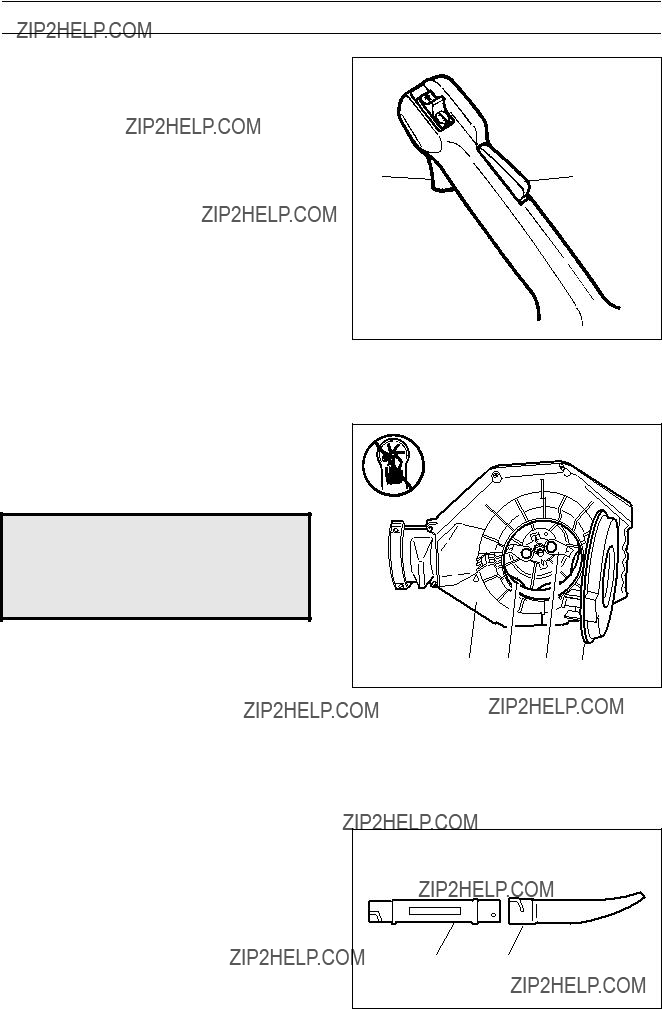
DESCRIPTION
Other equipment
Throttle trigger (2)
Fan casing (7)
The blower fan casing (7) together with the impeller (13) provide high performance air discharge.
Inspection
An inspection cover is located on the underside of the fan casing. Removal of this cover allows access for cleaning and inspecting the impeller. The inspec- tion cover can only be opened by means of tools.
If the vacuum tube is used, it must be fitted to the opening in the inspection cover as shown on page 16.
!WARNING!
Never start the blower if the inspection cover is not closed, is damaged or cannot be closed. (Exception: When the vacuum tube is fitted).
Cutters
Two cutters are fastened to the impeller. The cutters are there to mulch leaves and other debris, that have been vacuumed, before they enter the fan inlet.
Nozzle (14) and blower tube (15)
The nozzle and the blower tube have a bayonet mount for connection to the blower. Air is channeled through the blower tube to the nozzle, where the air discharge velocity increases and the air stream dis- charge pattern is formed to provide best perform- ance.
15 14
10 ??? English
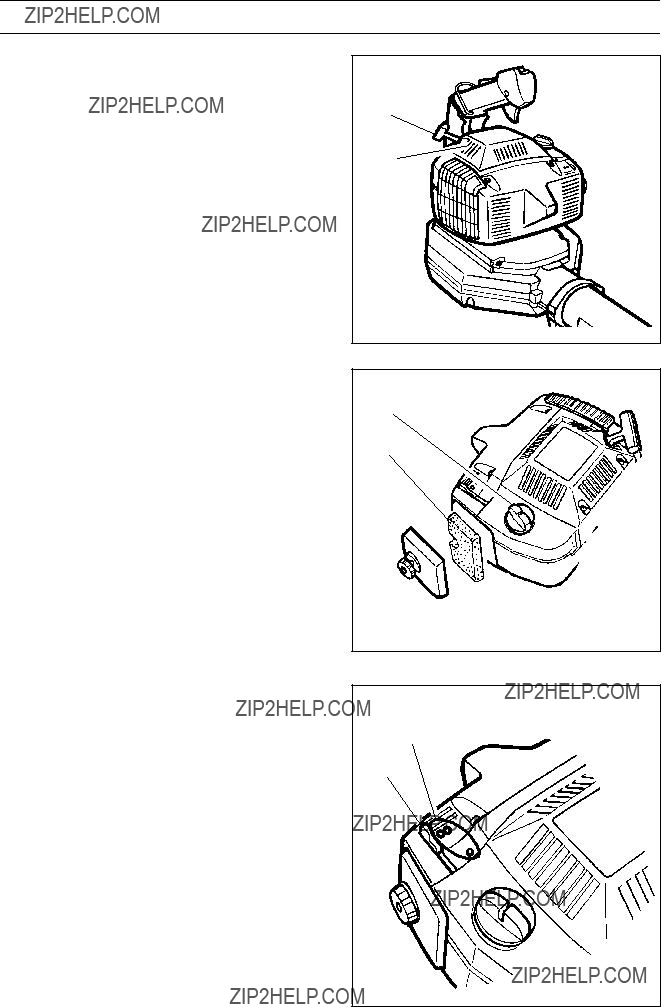
DESCRIPTION
Starter device (18) and starter handle (17)
The starter device is located at the top on the engine shrouding and engages in the crank shaft only when the starter handle is pulled.
Fuel cap (8)
The fuel cap (14) is located at the top of the engine shrouding and has a gasket, which prevents fuel from leaking out.
Air filter (9)
The air filter consists of
Choke (10)
The choke is located at the top of the engine shroud- ing and should be used every time the engine is
Adjusting the carburetor (19)
There are three adjusting screws for adjusting the carburetor:
???Low speed jet
???High speed jet
???Adjustment screw for idling
Adjusting the carburetor involves adapting the engine to local operating conditions, e.g. climate, altitude, gasoline and type of
For details about carburetor adjustment, see page 18.
17
18
8
9
19
10
English ??? 11
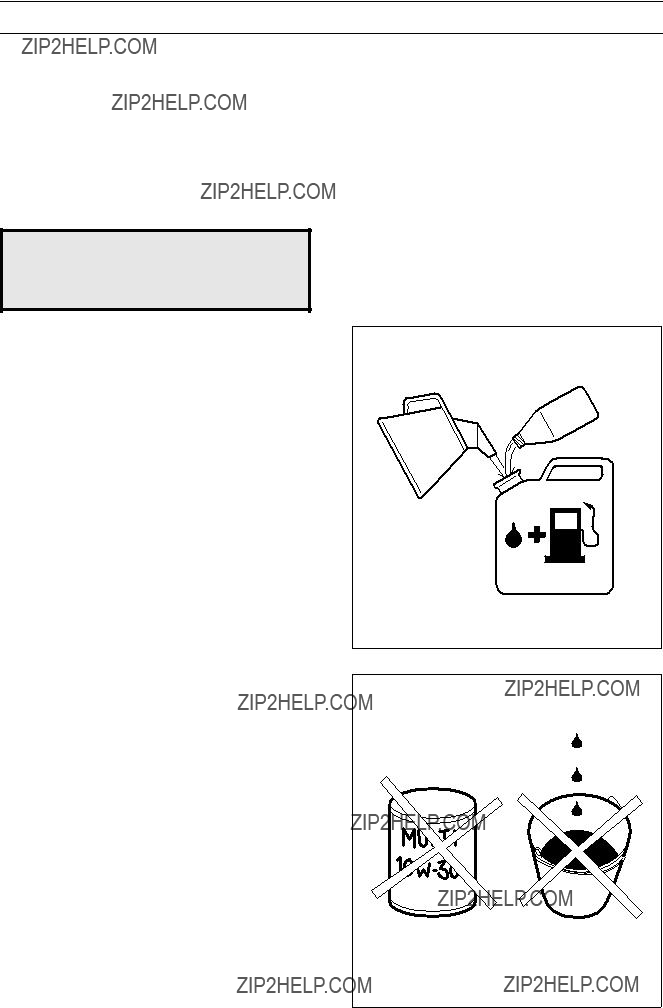
FUEL HANDLING
Fuel mixture
NOTE!
The machine is fitted with a
!WARNING!
Allow adequate ventilation while handling fuel.
Gasoline
NOTE!
Always use an
???This engine is certified to operate on
unleaded gasoline.
??? The lowest recommended octane rating is 87. If you run the engine on lower octane rating than 87
???When working at continuous high revs a higher octane rating is recommended.
???For the best performance, use HUSQVARNA
???If HUSQVARNA
Contact your dealer when selecting an oil.
???Never use
???Never use oil intended for
12 ??? English
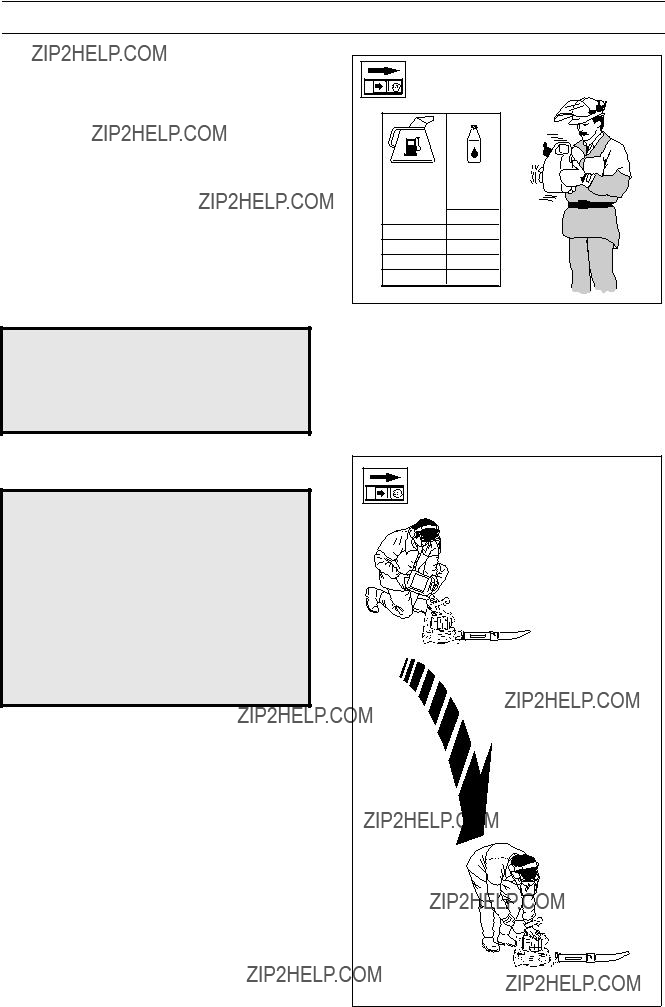
FUEL HANDLING
Mixture
???Always mix gasoline and oil in a clean container intended for fuel.
???Always start by filling half the quantity of gasoline required. Then add the entire oil quantity. Mix (shake) the fuel mixture. Fill the remaining quantity of gasoline.
???Mix (shake) the fuel mixture carefully before filling in the machine???s fuel tank.
???Do not mix more than max. one month???s supply of fuel.
???If the machine is not used for a long period of time, the fuel tank should be emptied and cleaned.
???This engine is certified to operate on unleaded gasoline.
!WARNING!
The catalytic converter muffler gets very hot during and after use. This also applies during idling. Be aware of the fire hazard, especially when handling the saw near flammable substances or vapours.
Fuelling
! WARNING!
The following precautions reduce the risk of fire:
Do not smoke or place any sources of heat in the vicinity of the fuel. Never refuel when the engine is running. Always stop the engine and let it cool for a few minutes before refuelling. Open the fuel cap slowly when fuelling so that any over pressure is released slowly. Tighten the fuel cap carefully after refuelling. Always move the machine from the fuelling place before starting.
???Ensure that the fuel is well mixed by shaking the container before filling the tank.
English ??? 13

START AND STOP
Start and stop
Start
! WARNING!
Never start the blower if the inspection cover is not closed, is damaged or cannot be closed. (Exception: When the vacuum tube is fitted).
A
Cold engine
IGNITION:
Set the stop switch to the start position.
CHOKE:
Set the choke control in the choke position
(A).
The choke position is also the automatic start throttle position.
AIR PURGE:
Press the air purge diaphragm repeatedly until fuel begins to fill the diaphragm. The diaphragm need not be completely filled.
IMPORTANT!
Do not pull out the starter cord completely and do not release the starter handle from the fully pulled out position. Doing so will damage the starter
Warm engine
IGNITION:
Set the stop switch to the start position.
CHOKE:
Set the choke control in the choke position and then back again to its original position (B) In this way only the start throttle is applied with no choke.
AIR PURGE:
Press the air purge diaphragm repeatedly until fuel begins to fill the diaphragm. The diaphragm need not be completely filled.
B
14 ??? English
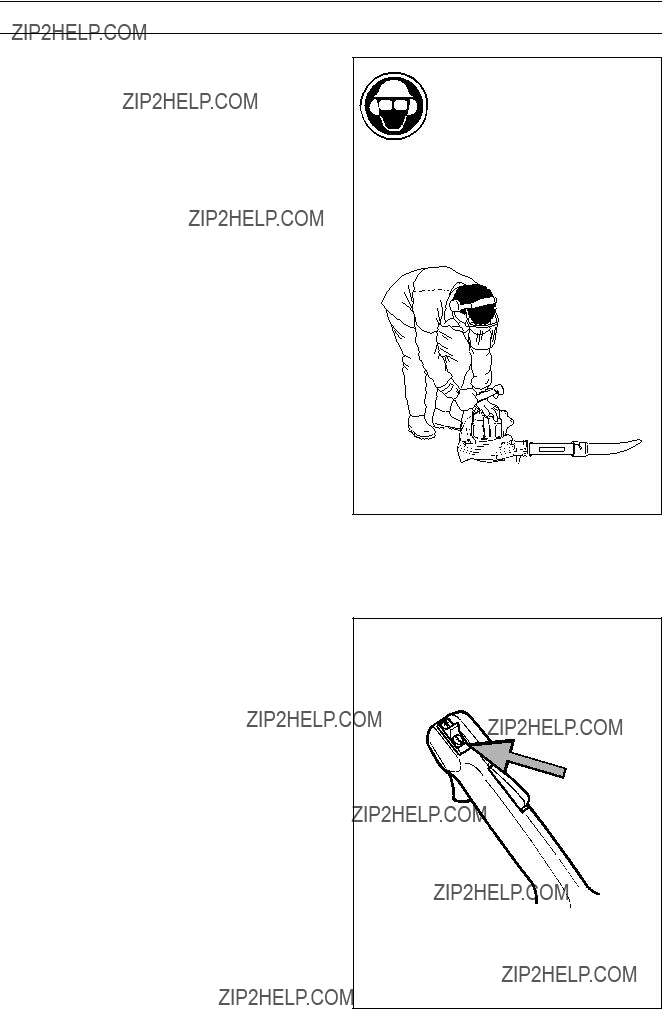
START AND STOP
Press the machine body against the ground using your left hand (NOTE! Do not use your foot). Grip the starter handle with your right hand and slowly pull the starter cord out until you feel some resistance, (the starter hooks grip) now quickly and powerfully pull the cord.
Immediately press the choke control in when the engine fires and repeat until the engine starts. When the engine starts, quickly apply full throttle and the start throttle will automatically disengage.
NOTE! Do not pull the starter cord out completely and do not release the starter cord from the fully extended position. This can damage the machine.
Stop
The engine is stopped by switching the ignition off using the stop switch.
English ??? 15
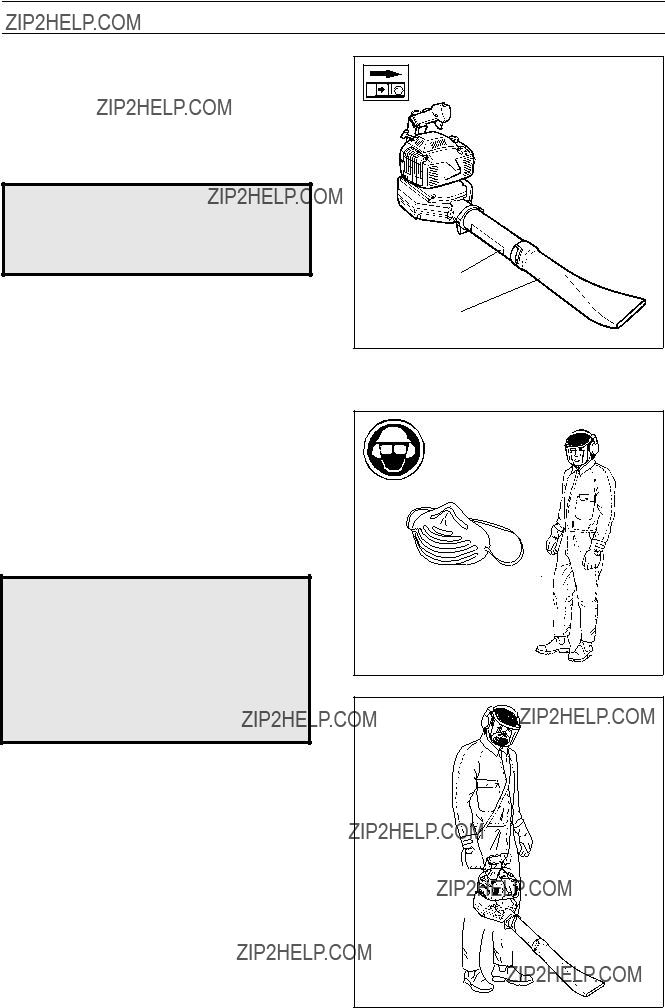
USING THE BLOWER
To blow away debris on the ground
Fitting the blower tube and nozzle on the blower
!WARNING!
When fitting the blower tube and nozzle, the engine must be switched off and the stop switch must be in the stop position.
The blower tube and nozzle have a bayonet mount. Fit them in the following manner:
1.Press the blower tube (15) against the blower air outlet and turn it 90 degrees until a snap is heard.
2.Fit the nozzle (14) onto the tube (15), and turn it 90 degrees until a snap is heard.
Blowing
Before you begin blowing, put on the required safety equipment.
!WARNING!
When working with the blower, wear the required protecting equipment:
1.Hearing protection.
2.Eye protection.
3.Face mask in dusty environ- ments.
When operating the blower, the blower must be secured to the shoulder strap. The strap should be worn over the shoulder as shown in the adjacent figure.
15
14
16 ??? English

USING THE BLOWER
!WARNING!
Never point the blower nozzle at people or animals. The
Be careful, particurlarly if left hand operation is applied. Avoid any direct body contact with the exhaust outlet area.
Start the blower as described on page 13. Work ac- cording to the following instructions:
1.Never blow air toward fixed objects such as walls, large rocks, automobiles and fences.
2.When working inside corners, blow from the corner and inward toward the centre of the work area. Otherwise, debris can fly up in your face and cause eye injury.
3.Never point the blower nozzle at delicate plants.
The
When blowing with greater accuracy and high air stream concentration is necessary, substitute the standard nozzle (14) with the

USING THE BLOWER
To vacuum debris from the ground
The vacuuming device is an accessory and is not included in the standard supply.
Fitting the collection bag with the various vacuum tubes
!WARNING!
When fitting the tubes to the blower, the engine must be switched off and the stop switch must be in the stop position.
1.Open the collection bag. Insert the collection bag tube from inside the bag to fit in the vacuum inlet opening of the bag as illustrated in the adjacent figure. Close the zipper on the bag.
2.Press the collection bag tube on the blower, turn it 1/4 of a turn until a snap is heard. The section of the tube that is covered by the collection bag must arranged with its outlet pointing downwards. Attach the carrying strap to the harness ring.
3.Open the cover at the underside of the blower, using a screw driver to disengage the locking piece in the square opening.
4.Press the vacuum tube in the large opening at the underside of the blower and turn it 45 degrees until the bayonet mount locks.
5.Push the lower vacuum tube onto the upper tube as shown in the adjacent figure.
6.Fit the auxiliary handle as described in the separate instructions.
Vacuuming
Before vacuuming, put on the required safety equip- ment.
!WARNING!
When working with the blower, wear the required protecting equipment.
1.Hearing protection.
2.Eye protection.
3.Face mask in dusty environments.
18 ??? English
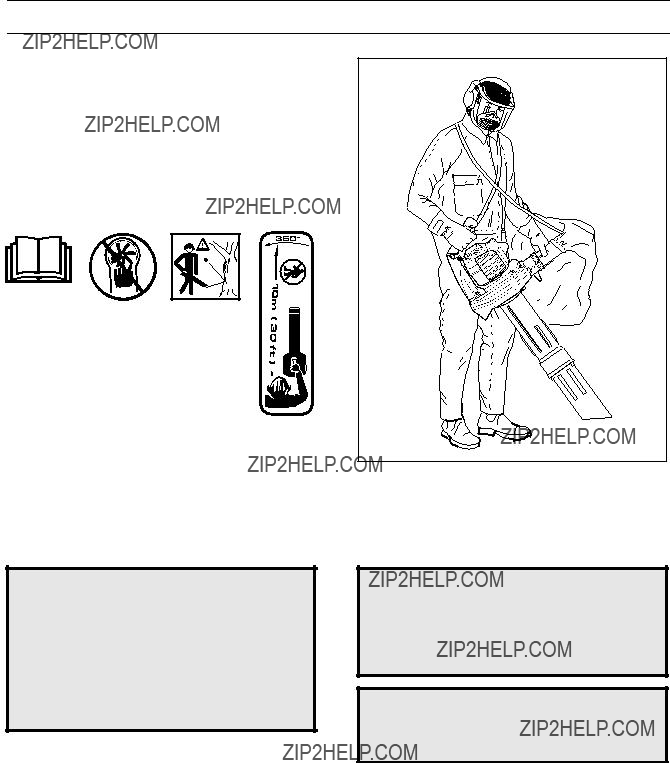
USING THE BLOWER
When operating the blower, the blower and collection bag must be secured in the shoulder strap. The strap should be worn over the shoulder as shown in the adjacent figure.
!WARNING!
Always check that the collection bag is intact and the zipper is closed before starting the blower. Never use a damaged bag. There is risk of injury due to flying debris.
Be careful, particurlarly if left hand operation is applied. Avoid any direct body contact with the exhaust outlet area.
Start the blower as described on page 13. Work ac- cording to the following instructions:
1.Do not vacuum large solid objects that can damage the fan, such as wood, cans (tins) or lengths of string or ribbon.
2.Do not let the vacuum tube strike the ground.
3.The bag can be emptied after having opened the zipper on the side.
!WARNING!
Never start the blower if the inspection cover is not closed, is damaged or cannot be closed. (Exception: When the vacuum tube is fitted).
!WARNING!
Do not operate the blower while standing on a ladder or a stand.
English ??? 19
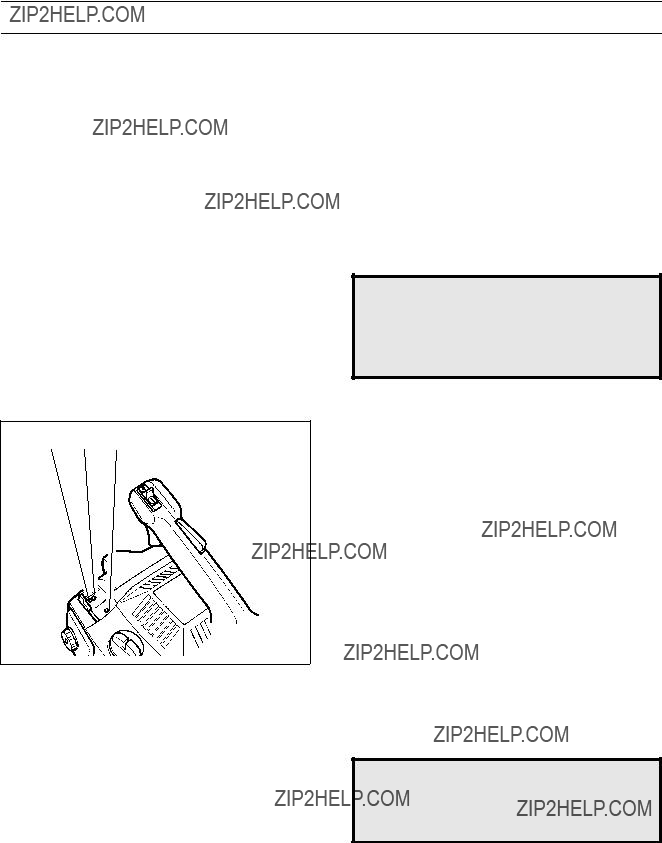
MAINTENANCE
Carburetor
The carburetor has been carefully preset at the fac- tory. However, additional adjustment may be required due to climate, altitude, gasoline and type of two- stroke engine oil used. The instructions below describe how carburetor adjustment should be carried out.
Basic (factory) settings
The carburetor is preset to the basic settings when the blower is tested at the factory. These basic settings are the following:
The H screw has been turned counterclockwise to its end position against the stop.
The L screw has been turned counterclockwise to its end position against the stop.
The carburetor governs the engine speed via the throttle. Air and fuel are mixed in the carburetor. The air/fuel mixture is adjustable. To utilize the blower???s maximum output, the settings must be correct.
The carburetor has three means of adjustment:
H = High speed jet
L = Low speed jet
T = Adjustment screw for idling
H L T
Function
The fuel quantity required in relation to the air flow, provided by the opening in the throttle, is adjusted by the L and H jets. If they are screwed clockwise, the air/fuel mixture becomes leaner (less fuel) and if they are screwed counterclockwise, the mixture becomes richer (more fuel). A leaner mixture gives rise to a higher engine speed and a richer mixture gives rise to a lower engine speed.
The T screw regulates the idling speed. Turning the T screw clockwise will increase the idling speed; turning it counterclockwise will lower the idling speed.
The recommended idling speed is 3000 rpm.
Adjustment
NOTE!
Do not remove the stops in the H and L jets. If these stops are removed, the blower will no longer satisfy the environmental requirements established by the California Air Resources Board.
Low speed jet, L
1.Check that the blower tube (15) and the nozzle (14) are mounted on the blower.
2.Turn the H and L adjustment screws fully counter- clockwise so that they rest against the stop.
3.Start the blower engine, see page 13, and alternate letting it run at idling speed and at half throttle for
4.Set the T screw to the setting, at which the engine runs precisely at idling speed, but not faster.
5.Make a fine adjustment, turning the L screw so that the engine will run at max. idling speed. Then turn the L screw max 1/4 of a turn counterclockwise.
6.Then turn the T screw to increase the engine speed, if necessary.
NOTE!
When setting the H jet, the max. permissible
High speed jet, H
1.Start the blower as described on page 13 and alternate letting it run at idling speed and at half throttle for
2.Give the engine full throttle and adjust the H screw until the engine runs at maximum speed.
3.Turn the H screw 1/8 of a turn counterclockwise (less than 1/8 of a turn if the stop restricts this adjustment).
20 ??? English
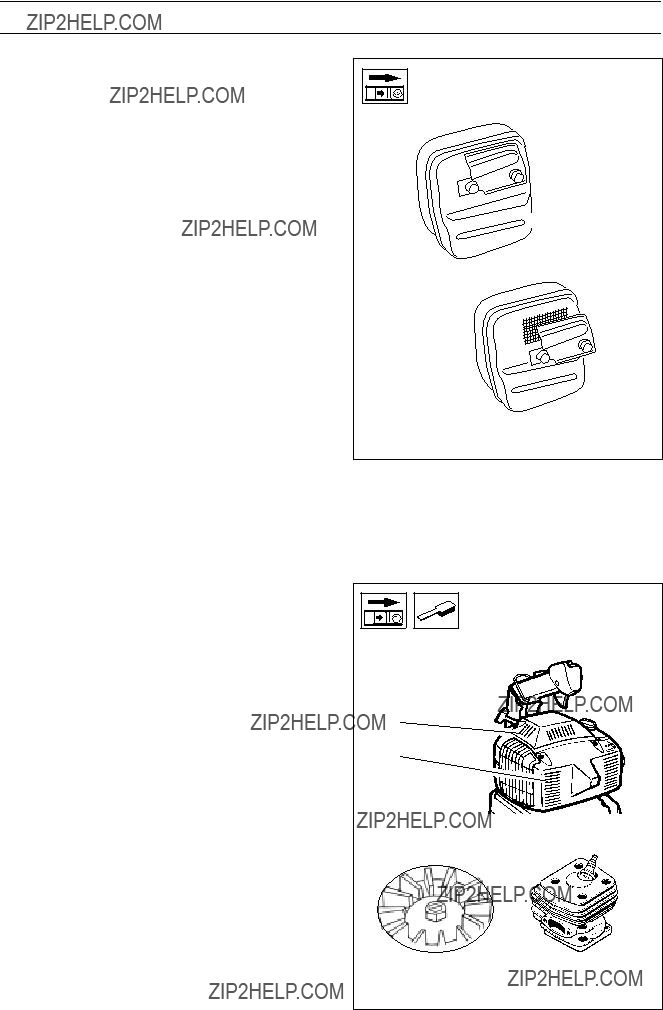
MAINTENANCE
Muffler
NOTE!
Some mufflers are fitted with a catalytic converter. See ???Technical data??? to see whether you clearing saw is fitted with a catalytic converter.
The muffler is designed to dampen the noise level and to direct the exhaust fumes away from the user. The exhaust fumes are hot and can contain sparks, which can result in fire if the exhaust fumes are directed towards a dry and inflammable material. Some mufflers are equipped with a special spark arrest screen. If your machine is fitted with this type of screen it should be cleaned regularly. This is done using a wire brush. On mufflers without a catalytic converter the screen should be cleaned weekly, or replaced if necessary. On mufflers fitted with a catalytic converter the screen should be checked and cleaned monthly. If the screen is damaged it should be replaced. If the screen is frequently blocked, this can be a sign that the function of the catalytic converter is impaired. Contact your dealer to inspect the muffler. A blocked screen will cause the engine to overheat resulting in damage to the cylinder and piston. Also see under ???Maintenance???.
NOTE!
Never use a machine with a defective muffler.
Cooling system
The engine is equipped with a cooling system for maintaining the right operating temperature.
The cooling system consists of the following components:
1.Air intake on the starter device.
2.Fan blades on the flywheel.
3.Cooling fins on the cylinder.
4.Cylinder cowling (guides cooling air flow against cylinder surfaces).
Clean the cooling system by brushing once a week, or more often, if necessary.
A dirty or blocked cooling system will cause the blower to overheat and this will damage the cylinder and piston.
1
4
English ??? 21

MAINTENANCE
Air filter
The air filter (A) must be cleaned regularly to remove dust and dirt. This will prevent:
???Abnormal fuel consumption
???Elevated content of harmful exhaust fumes
Clean the filter after 25 hours of operation or more often if the air is exceptionally dusty in the work area.
To clean the air filter
Dismantle the air filter cover (B) and remove the filter medium. Wash it clean in a solution of soap and warm water. Make sure that the filter is dry before reassembling.
An air filter, which has been used for some time, can- not be cleaned completely. Therefore,the filter must be replaced by a new one at regular intervals. A faulty filter must always be replaced.
Spark plug
The condition of the spark plug is influenced by:
??? An incorrectly adjusted carburetor.
???Wrong fuel mixture (too much oil in the gasoline).
???Poor quality gasoline and/or oil.
These factors cause deposits on the spark plug electrodes, which may result in malfunction and difficulty starting the blower.
If the engine is low on power, difficult to start or runs poorly at idling speed, always check the spark plug first.
The spark plug is accessible under the cylinder shrouding, which can be removed by unscrewing four screws.
If the spark plug is clogged, clean it and check the electrode gap.
NOTE! Always use the recommended type of spark plug! See under ???Technical data???. An incorrect spark plug can severely damage the piston/cylinder.
22 ??? English
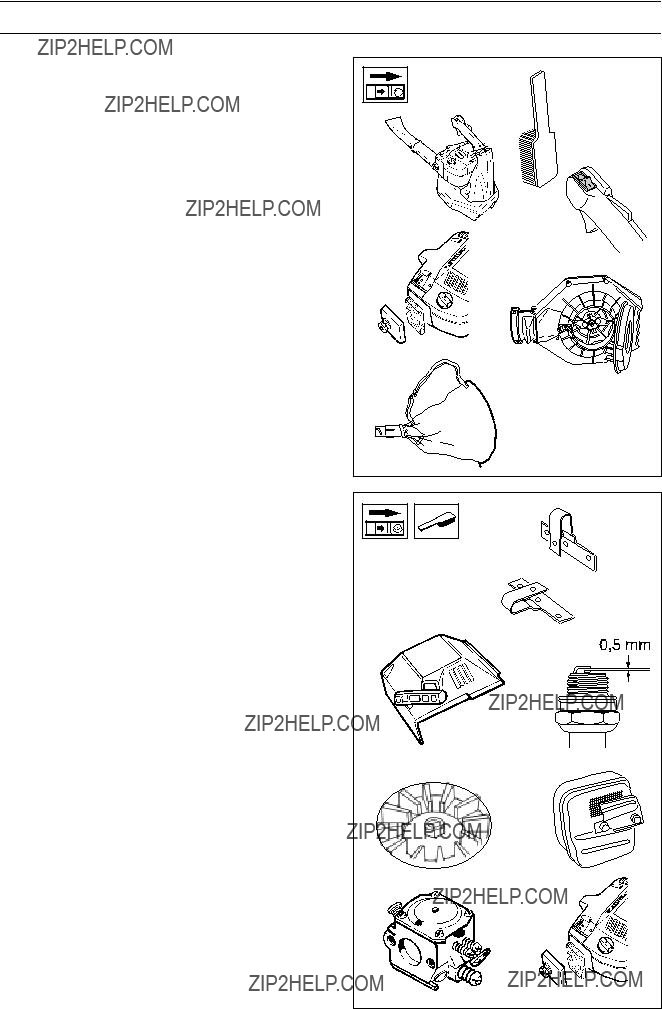
MAINTENANCE
Maintenance schedule
A number of general maintenance instructions are given below. If more detailed instructions are required, get in touch with your local servicing dealer.
Daily maintenance
1.Clean the exterior surfaces of the blower.
2.Check that the throttle lock and the throttle trig- ger function in a safe manner. Replace damaged parts.
3.Check that the stop switch works properly. Replace if necessary.
4.Clean the filter. Replace it, if required.
5.
especially if the blower has been used for collecting debris (vacuuming).
6.Check that all nuts and screws are properly tightened.
7.Check that all the housings are free of cracks. Damaged parts shall be replaced.
8.Check that the collection bag is intact and that the zipper works. Replace it, if required.
Weekly maintenance
1.Check the condition of the starter device, the starter cord and the tensioning spring. Damaged parts shall be replaced.
2.Check that none of the
3.Check the condition of the air intake at the starter device. Remove debris if it is clogged.
4.Clean the outside of the spark plug. Unscrew it and check the electrode gap.
5.Clean the fan blades on the flywheel.
6.Clean or replace the muffler???s spark arrest screen (not on mufflers with a catalytic converter).
7.Clean the carburetor space.
8.Clean the air filter.
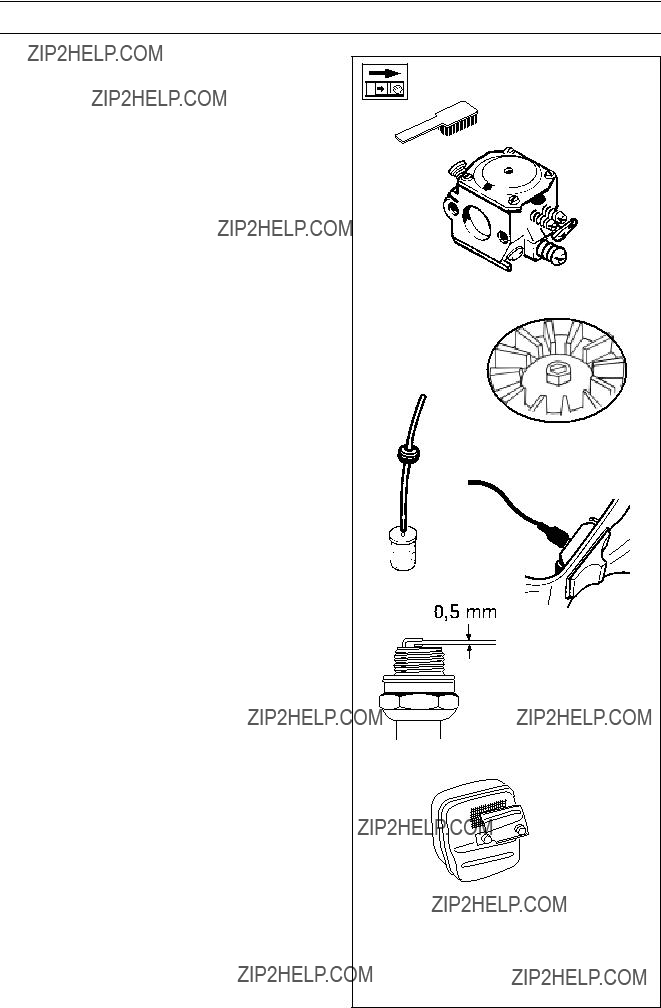
MAINTENANCE
Monthly maintenance
1.Flush the fuel tank with clean gasoline, which afterward should be disposed of in an environ- mentally correct manner.
2.Clean the outside of the carburetor and the space around it. Replace damaged parts.
3.Clean the fan blades on the flywheel and the space around it.
4.Check the fuel filter and the fuel line. Replace them, if necessary.
5.Check all the cables and the connections. Replace damaged parts.
6.Change the spark plug.
7.Check and clean the muffler???s spark arrest screen if necessary (only mufflers with a catalytic converter).
2
3
4
5
6
7
24 ??? English

TECHNICAL DATA
26,9
35
28
3.000
8.200
7.400
0.9 kW/9000 rpm Yes
Walbro CD Champion RCJ 7Y 0.5
Walbro/WT
0.4
5.3
91
100
3,6
3,5
Radial fan 83 (300) 600
English ??? 25
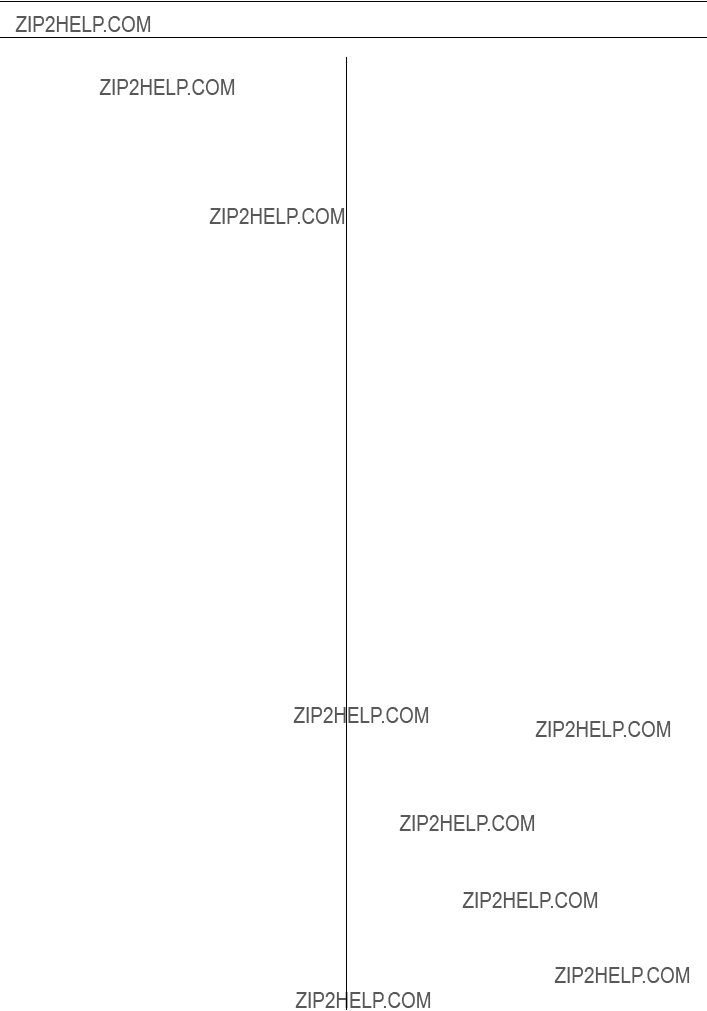
FEDERAL AND CALIFORNIA EMISSION CONTROL WARRANTY STATEMENT
YOUR WARRANTY RIGHTS AND
OBLIGATIONS
The EPA (U.S. Environmental Protection Agency), CARB (California Air Resources Board) and Husqvarna Forest & Garden are pleased to explain the emissions control system warranty on your 2001 and later small
Your emission control system includes Parts such as the carburetor and the ignition system.
Where a warrantable condition exists, Husqvarna Forest & Garden will repair your small
MANUFACTURER???S WARRANTY
COVERAGE
The 2001 and later small
OWNER???S WARRANTY
RESPONSIBILITIES
As the small
As the small
You are responsible for presenting your small
If you have any questions regarding your warranty rights and responsibilities, you should contact your nearest authorized servicing dealer or call Husqvarna Forest & Garden at
WARRANTY COMMENCEMENT DATE
The warranty period begins on the date small
LENGTH OF COVERAGE
Husqvarna Forest & Garden warrants to the initial owner and each subsequent purchaser that the engine is free from defects in materials and workmanship which cause the failure of a warranted part for a period of two years.
WHAT IS COVERED
REPAIR OR REPLACEMENT OF PARTS
Repair or replacement of any warranted part will be performed at no charge to the owner at an approved Husqvarna Forest & Garden servicing dealer.
If you have any questions regarding your warranty rights and responsibilities, you should contact your nearest authorized servicing dealer or call Husqvarna Forest & Garden at
WARRANTY PERIOD
Any warranted part which is not scheduled for replacement as required maintenance, or which is scheduled only for regular inspection to the effect of ???repair or replace as necessary??? shall be warranted for 2 years. Any warranted part which is scheduled for replacement as required maintenance shall be warranted for the period of time up to the first scheduled replacement point for that part.
DIAGNOSIS
The owner shall not be charged for diagnostic labor which leads to the determination that a warranted part is defective, if the diagnostic work is performed at an approved Husqvarna Forest & Garden servicing dealer.
CONSEQUENTIAL DAMAGES
Husqvarna Forest & Garden may be liable for damages to other engine components caused by the failure of a warranted part still under warranty.
WHAT IS NOT COVERED
All failures caused by abuse, neglect or improper maintenance are not covered.
ADD
The use of
HOW TO FILE A CLAIM
If you have any questions regarding your warranty rights and responsibilities, you should contact your nearest authorized servicing dealer or call Husqvarna Forest & Garden at
WHERE TO GET WARRANTY SERVICE
Warranty services or repairs shall be provided at all Husqvarna Forest & Garden authorized servicing dealers.
MAINTENANCE, REPLACEMENT AND
REPAIR OF
Any Husqvarna Forest & Garden approved replacement part used in the performance of any warranty maintenance or repairs on
EMISSION CONTROL WARRANTY PARTS
LIST
1.Carburetor and internal parts
2.Intake pipe, airfilter holder and carburetor bolts.
3.Airfilter and fuelfilter covered up to maintainance schedule.
4.Ignition System
a)Spark Plug, covered up to maintenance schedule
b)Ignition Module
5.Muffler with catalytic converter
MAINTENANCE STATEMENT
The owner is responsible for the performance of all required maintenance, as defined in the operator???s manual.
??+H"[??5B??
??+H"[??5B??
2001W32